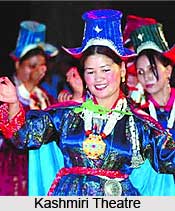 Moti Lai Kemmu was born in the year 1933. He was a Kashmiri playwright, actor, critic, Kathak dancer, and a pioneer in uniting folk-theatre forms with contemporary performing arts. After graduating from the University of Kashmir, he received formal training in Indian dance and drama under C. C. Mehta at M. S. University in Vadodara, Gujarat. In later days he worked ceaselessly in reviving Kashmiri theatre, retiring as Additional Secretary of the Jammu and Kashmir Academy of Art, Culture and Languages.
Moti Lai Kemmu was born in the year 1933. He was a Kashmiri playwright, actor, critic, Kathak dancer, and a pioneer in uniting folk-theatre forms with contemporary performing arts. After graduating from the University of Kashmir, he received formal training in Indian dance and drama under C. C. Mehta at M. S. University in Vadodara, Gujarat. In later days he worked ceaselessly in reviving Kashmiri theatre, retiring as Additional Secretary of the Jammu and Kashmir Academy of Art, Culture and Languages.
Kemmu drew upon the folk genres of Bandi Pethir and Bhavai, classical Sanskrit theatre and modern Western drama, fusing a variety of elements in his attempt to produce `total theatre`. He applied several methods to bring antiquity nearer contemporaneity and make his drama palatable to present-day audiences. Moti Lai Kemmu believed that the burlesque and buffoonery of the Bandi tradition facilitated communication in a lively manner. He employed the time-honoured sutradhara of Sanskrit dramaturgy, but transformed him into characters named Adarang and Sadarang. He used a chorus in the manner of Western theatre, to comment on the action through simple lyrics resembling folk rhymes. He did not want his plays to be unidirectional performances but, as in folk ritual, endeavoured to get his audience to participate. Kemmu actively promoted Bandi as well as the Dhamali dance, organizing workshops for actors and documenting Kashmiri art forms. Most of the plays contained in his four collections. The names of the collections can be mentioned as Trunove i.e. `Three Names`, Lai bi drayas lolarey i.e. `Lai in Love`s Quest`, Natak truch i.e. `Three Dramas`, and Dakh yeli tsalan i.e. `When Supports Fall`. These have been staged repeatedly in Kashmir and elsewhere in India. Tshay i.e. `Shadow` in 1972 is an excellent exploration of the universal conflict between faith and doubt. For this Moti Lai Kemmu won the Sahitya Akademi Award. It was based on the backdrop of the eighth-century expedition of Kashmir`s Raja Lalitaditya, as depicted in Kalhana`s Rajatarangini. Kemmu foregrounds a group of soldiers marooned in a blizzard, even in their death throes trying to anchor their faith in the King`s divine powers, while a young recruit, Tsandra, is alienated in his skepticism. Haram khanuk eni i.e. `Mirror of the Harem was memorably produced by the Kashmir Theatre Federation during the 1970s. The one-act play Toti ti eni i.e. `Parrot and Mirror` in 1984 is a combination of folk tale, song, and dance.




















